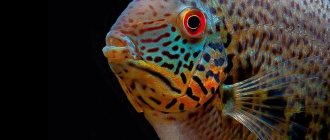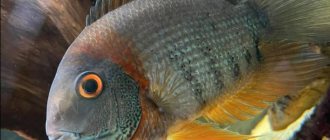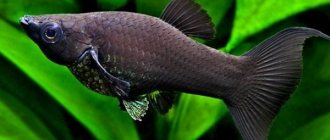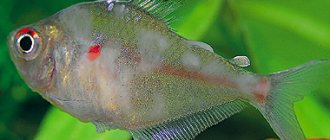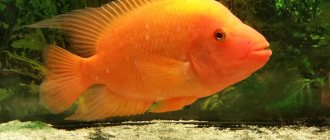Severum cichlazoma is a colorful member of the cichlid family. Due to its similarity to another member of this large family, severum is sometimes called a false discus, but true discus are somewhat larger.
These fish are distinguished by their refined body structure and varied colors, which makes them desirable inhabitants of species-specific reservoirs.
Clowns
Some of the most popular among fans are the Pomacentraceae family. These are reef inhabitants of subtropical and tropical seas. These fish look dense and strong, they have very bright colors. But the real favorite of aquarists is the clown fish due to its small size and increased resistance to harmful factors and diseases. This family is also attracted by its unusual behavior. For example, clown fish can coexist with poisonous polyps. The reasons for this cohabitation still remain a mystery to scientists.
Clownfish and sea anemone form a symbiotic relationship. At first, the fish allows itself to be stung a little, and then it produces a protective substance and settles near the poisonous one.
polyp without fear of predators. At the same time, the clown “looks after” its sea anemone, removing leftover food, conditioning the water, and even attracting other living creatures to feed the polyp. This is how sea anemone and clown fish provide each other with protection and benefit. The clown itself feeds on zooplankton and algae.
Another amazing species to imagine is the orange amphiprion. This is a bright fish with large white and orange stripes. In one herd there is always only one breeding pair and several small males. They are not capable of reproduction and their role is still unclear.
Basically, amphiprions are peaceful, especially if there is only one school with one polyp in your pond. Although it is recommended to have not one sea anemone, but two, for a possible new family.
Most Pomacentra feed on crustaceans, worms and echinoderms, some on plankton and algae. They are very mobile, but love to hide in numerous shelters. Amphiprions and clowns are compatible with any inhabitants of the aquarium, except seahorses and moray eels.
Nemo
This type of clown became especially popular after the release of the cartoon Finding Nemo. This is an anemone fish up to 9 cm long that lives in coral reefs. The color of the nemo is red-orange with three vertical white stripes on the “stem” of the tail, in the middle of the body and on the head. All young animals of this species are males.
As a rule, one anemone contains a spawning pair of different sexes and about two or three asexual fry. The Nemo fish acquires its gender during its life, often due to the death of the female. It feeds on algae and small invertebrates.
Description
Amphiprion lives in reefs and lagoons of the Pacific and Indian Oceans. The natural home for clown fish are sea anemones (anemones), poisonous coral polyps. The amphiprion and sea anemone have a symbiosis: the sea anemones protect the clowns from predators, and the fish clean the polyp from food debris and take care of it. Amphiprions are also valued for their ability to make sounds resembling clicks.
Appearance
The average size of a clown fish is 9 cm. The body is oval, the fins are rounded. The dorsal fin has 14–17 rays and has an opening in the middle, which creates the appearance of two dorsal fins. Typical colors for amphiprion: dark blue, orange, white, black, brown. The color depends on the species and color variation. The iris of the eyes is orange, the head is convex. The fins have a dark border.
Behavior
In nature, clowns are peace-loving fish, but in aquarium conditions they become aggressive. In captivity, amphiprions are territorial, jealously guarding their shelter. Aggression in clowns is provoked by solitary confinement or lack of food in the aquarium. Fish change sex, adapting to environmental conditions. All newborn clownfish are male. In the absence or death of a female, as well as when kept alone, the fish change sex to female.
Lifespan
The average lifespan of marine species is 10 years. In captivity, clownfish live 15–20 years if properly maintained.
Blenny
Family Canine - bottom hermits These fish are ideal for a reef aquarium. In nature, they live on reefs and keep under their “control” the green algae that they feed on. In the aquarium they also eat algae, fresh greens and frozen food. These are small fish with an elongated body, similar to eels. Usually the dog lives alone in reef crevices, caves, burrowing into the sand or “settled” in empty mollusk shells. There are not many “enemies” for her in the aquarium: moray eel, stingray. Doesn't get along well with spiny fish either.
How to choose?
You should buy aquarium inhabitants only from trusted places, so as not to purchase diseased specimens. These can be either professional fish stores or private owners who independently breed ornamental fish.
It is very important to think in advance which fish you want to place in the same aquarium, since many of them do not get along with each other and can be aggressive.
When choosing fish, you should take into account the temperature regime of the water, which is suitable for the habitat of a particular species, because for some species a temperature of 20-23 degrees is quite acceptable, while for others it is at least 26. Usually this point should be checked with fish sellers.
Surgeon fish
Surgeon fish are every hobbyist's dream. These saltwater aquarium fish are striking in their deep blue color with yellow stripes and scalpel-like bony projections.
The surgeon was drying
The most spectacular representative of this species is the surgeon sokhal. His steel-gray body is streaked with black stripes. Against this black and white background, the orange tail spine and a small spot behind the gill cover stand out brightly. The aquarium fish Sohal measures about 8 centimeters, although in nature it reaches 40 cm. When kept in a home pond, it makes special demands. In total, a minimum of 700 liters is required for one individual. Sohal is a tireless swimmer who needs a lot of free time.
space. However, even if your pond can accommodate more fish, you should keep in mind that many of these species are aggressive towards their own species. And it's better to keep them alone. And even the surgeon may be unfriendly towards other species, and it is better to place it in a common aquarium among the latter. Only moray eels and sharks can threaten him. It feeds on green algae and sargassum.
Body
These amazing inhabitants of the tropical seas seem to be bound by a bone shell. As a result, their body has the appearance of a box with three, four or five sides and is completely motionless. Because they are very
slow, only moving the very end of the tail slightly. Fans of sea waters especially prefer one of the species - the horned fish. It sticks to rocky coastal areas and feeds on small crustaceans and algae. The length of the horned body is no more than 18 centimeters and has a tetrahedral shell. Long spikes like horns protrude above the large eyes. For this exotic look, dried bodies are often used as decorations. The meat of the horned boxfish is poisonous, so no one is dangerous to it, but it is better not to place it in the same aquarium with species that aggressively fight for food. A slow box will starve.
Nuances of care
In order for the fish to feel comfortable, it is very important to approach the choice of their place of residence as carefully as possible. So, according to many experts, for every 5 cm of the body of any fish, 2 liters of water are needed.
If you have just decided to start breeding aquarium inhabitants, then it is highly undesirable to purchase expensive and exotic varieties. They require special care.
It should be remembered that not all species are friendly, many of them are aggressive. Often large varieties of fish are not always “happy” with their small neighbors.
Food should be selected based on the needs of the species that will live in the aquarium. It is advisable to remove the remains of uneaten food from the container as soon as possible. Sudden changes in temperature in the aquarium should not be allowed; it should be installed according to what types of fish live there. It is advisable to place the aquarium in a remote place away from all kinds of vibrations, equipment and outside noise.
How to care for swordtails and reproduce them, see below.
Source
Angels with bad temperament
Angelfish are one of the most colorful fish in the sea.
started by experienced amateurs. The reason lies in sensitivity to water quality and pickiness in nutrition. Despite the name, they do not have such an angelic character and large individuals are at enmity with each other. Therefore, one angel is enough for one aquarium. Dwarf angelfish, growing up to 12 cm, have the best viability. They feed on plants and small organisms, but the food must be well balanced.
Centropyg - the most unpretentious of angels
Everyone's favorite angel is Centropygus. They come in different shades - blue-violet with gold, red, among them the fiery centropyg stands out. This is a surprisingly elegant fish of bright orange color with small black stripes up to 10 cm in size.
It gained its popularity among amateurs due to its excellent endurance and adaptation in captivity. She prefers clear water, although she leads
benthic lifestyle near the shelter. It lives in small harem groups and feeds on crustaceans and algae.
Adviсe
- For a beginner, clowns bred in captivity are suitable. Such fish are accustomed to dry food and adapted to aquarium conditions due to their origin.
- Place new fish in a quarantine tank for several weeks to identify possible diseases.
- When buying fish, evaluate their appearance: the color should be bright, the skin should be free of abrasions and injuries, and the eyes should be free of clouding.
- Aquarium-bred clownfish sometimes need to adapt to living with sea anemones. Give your pet time to get to know his wonderful companion.
- Use a refractometer to measure the salinity of the water.
Some fish imitate amphiprions and try to contact sea anemones, despite the fact that this is not inherent in them by nature. This interesting behavior has been observed in angelfish and stingrays.
Previous
Fish: 7 popular aquarium cichlid fish and their maintenance
Next
FishUnpretentious and beautiful scarlet barb fish
Pseudochromis - fish for beginners
These small tropical creatures come in all the colors of the rainbow - a real find for the novice saltwater aquarium enthusiast. They have excellent adaptability for being kept in captivity. In nature, these fish live in rock crevices and coral branches, without moving away from their shelter. To feed, some pseudochromissas need a lot of “live stones” in the aquarium, where they find small crustaceans, worms, etc. If you want to have several specimens of this species, you need to take care of a large container and the absence of large predators in it.
Lionfish and wrasses
There are other families and species of sea fish from which it is worth creating your own home underwater world. For example, real extreme sports enthusiasts breed representatives of the poisonous Scorpionidae family. Particularly popular
beautiful zebra lionfish and warrior lionfish, as if with elegant feathers, they are surrounded by numerous fin spines. Another name for it is sea ruff. This is a predator that lurks at the bottom and instantly grabs unwary neighbors with a suction movement. Scorpionfish need a spacious pond with a pebble bottom and plenty of hiding places. In the same body of water, only angelfish, boxfish and groupers peacefully coexist with them. You need to feed lionfish with live small fish, but you can gradually switch to shrimp. Another joy for the novice aquarist is the Wrasses family. They are very attractive, active and unpretentious in maintenance. In case of danger, wrasses prefer
bury yourself in the sand. They get along well with most aquarium inhabitants, although they can become food for sharks, moray eels and lionfish. Wrasses themselves eat shellfish and other invertebrates.
Triggerfish and fox fish
The Triggerfish family has a completely quarrelsome character. They are so named for their ability to anchor themselves in stones and rocks using their dorsal fin. Triggerfish feed on molluscs, sea urchins, corals, stars and crustaceans. Therefore, they are not kept together with invertebrates.
The fox of a marine aquarium is a brilliant creature of bright yellow color with a white and black head. It belongs to the Whitefish family and in an aquarium can reach 15 cm. Since the fox fish has sharp and poisonous fins, it should not be picked up by hand. But this is where its danger ends. In general, she is very peaceful. She's sensitive
to the quality of water and darkens when feeling unwell, but when it improves it restores its color. Out of five points in terms of survival, it safely “takes” four, therefore it is recommended for beginning aquarists. These fish are kept singly or in pairs. They are peaceful herbivores, preferring frozen seaweed meals, plenty of swimming space and plenty of reefs to hide in. Although it may show an appetite for crustaceans.
Keeping seahorses
Seahorses have an unusual appearance - their front part resembles the arched neck and head of a horse. This is the only fish whose head is not located in line with the body, but at a right angle. It swims “standing up”, very slowly and can change color. Like knights, they are covered with a hard shell and are motionless. And his tail is not a fin, but like a chameleon’s. It clings to plants with it.
Seahorses in the aquarium feed on live mysids, coretra, daphnia, bloodworms, and brine shrimp. For them, you need to arrange a quiet place where they will not be disturbed by nimble representatives of the marine fauna. There should also be enough plants to which the skates attach their tails.
Due to their inactivity, skates do not get along well with most of their nimble neighbors. It is better to keep them together with tangerines.
Diseases
Amphiprions have strong immunity. Diseases appear in water of poor quality or unsuitable parameters. Characteristic for the type of disease:
- Brooklynellosis (marine costiosis). Accompanied by white spots on the body and lethargy. It is treated with copper sulfate at a concentration of 1.5 mg per liter of water or 0.04 mg of malachite green per liter of water.
- Oodiniosis. The amphiprion becomes covered with a white rash, the scales peel off, and the fins stick together. Treated with copper sulfate.
- Cryptokaryonosis is a common disease in marine aquariums. The external signs resemble ichthyophthyriosis - white dots appear on the body of the affected individual. It is treated by reducing the salt concentration in water with the addition of formalin or copper sulfate.
- Amyloodinosis. This disease is easy to confuse with the previous one due to similar manifestations. Specialty medications are available for sale.
Moray eel in a marine aquarium
There are more than a hundred species of moray eels. These fish, similar to a ferocious snake, live not only in the tropics, but also in the seas of temperate latitudes. The small moray eel gets along well in an aquarium with a wide variety of inhabitants, creating a spectacular illusion of the ocean floor. True, due to its predatory nature, the moray eel does not get along with everyone. Its neighbors can be angelfish, boxfish, groupers and lionfish. Moray eels eat not only fish, but also crustaceans. Therefore, the aquarium moray eel should live with large fish. Small specimens (up to 30 cm), for example, snow moray eels, are suitable for keeping in captivity. It is quite easy to maintain even for an inexperienced amateur. True, the aquarium should always be tightly closed so that this fish does not crawl out to freedom.
Kinds
About 30 species of clowns are suitable for keeping in an aquarium. All these species live in sea anemones.
Saddle Clown
Peaceful view. The body color is dark, there are two white stripes. The lower fins are yellow. The average size of males is 7 cm, females - 11–12 cm.
Clown percula
Most often, fish of the species Amphiprion percula are bred artificially. The predominant color is orange, and there are three white stripes outlined in black on the body. The fins have a dark edging. Externally, the amphiprions Ocellaris and Percula are poorly distinguishable: the dorsal fin of Ocellaris has 10–11 rays, while Amphiprion percula has 9–10.
